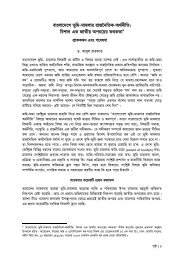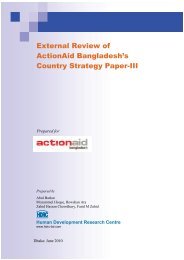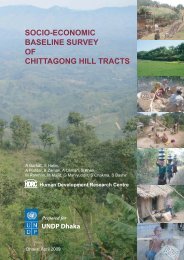08. Costing Essential Services Package An Issue Paper
08. Costing Essential Services Package An Issue Paper
08. Costing Essential Services Package An Issue Paper
You also want an ePaper? Increase the reach of your titles
YUMPU automatically turns print PDFs into web optimized ePapers that Google loves.
<strong>Costing</strong> <strong>Essential</strong> <strong>Services</strong> <strong>Package</strong>: <strong>An</strong> <strong>Issue</strong> <strong>Paper</strong> 14<br />
6. Policy, Regulation, NGO, Private Sector (PRNP)<br />
7. Other Public Health <strong>Services</strong> (OPHS)<br />
8. Other Health and Nutrition <strong>Services</strong> (OHNS).<br />
In costing total expenditure for ESP (TEESP) it has been assumed that the first component i.e.;<br />
ESP is totally (fully) included in the TEESP, and in each non-ESP (7 components) component,<br />
there is ESP in varied degree which is included in TEESP. Thus, methodologically, PPC has<br />
divided the expenditure of HPSP into two broad categories (Figures 9 and 10):<br />
� expenditures for ESP delivery; and<br />
� expenditures for other HPSP activities (denoted as non-ESP) including those which are<br />
directly or indirectly related to ESP delivery and hospital services.<br />
As part of the PPC’s ESP costing exercise, several Task Forces (TF) were constituted by the<br />
MOHFW to deal with the issue in line with the HPSP components. The TFs categorised the<br />
activities among seven components considering mainly the ease and convenience of<br />
management, i.e., considering which line manager will better administer which component of<br />
HPSP. As a result of such consideration, it is not possible to separate out all the activities<br />
directly related to ESP in one component (ESP delivery) from the components, which are also<br />
related to ESP delivery. Hence, some of the HPSP components other than ESP delivery also<br />
include some activities that are directly related to ESP delivery. For example, training of the<br />
grass-root levels staff and officials (at thana level or below) for ESP is an activity under the HRD<br />
component. But this is definitely an ESP activity, not included in the component 1 i.e., ESP<br />
delivery (GoB 1998a: 71).<br />
Before the pre-appraisal mission, following a top-down procedure, a notional estimate of costs<br />
of ESP delivery activities was obtained. This estimate was included in the original PIP for preappraisal.<br />
The procedural steps adopted in this top-down exercise were as follows:<br />
(a) notional determination of amount of expenditure for each component,<br />
(b) allocation of amounts by activities and sub-activities.<br />
A Working Group, formed during the pre-appraisal, revisited and further refined the estimate.<br />
After the mission, the estimate was placed at a workshop with technical group for finalization.<br />
The workshop participants pointed out several changes required in the estimate, and constituted<br />
two Review Groups for reviewing the estimate. The two Review Groups consulted a large<br />
number of concerned persons and finally obtained an estimate for each intervention by level of<br />
care (GoB 1998a : 72).<br />
After pre-appraisal, the estimation procedure incorporated the bottom-up approach. According<br />
to this procedure, the personnel of the relevant departments first identified the activities and<br />
sub-activities to be conducted in the first year of HPSP to produce each ESP outcome over the<br />
targeted coverage. Thereafter they assessed the type of inputs/line items of costs and the<br />
amount of costs for each type of inputs to be used to produce each unit of outcome. Then the<br />
total costs for each outcome was estimated at the current market price, and finally the grand<br />
total of ESP delivery expenditures was obtained for the first year – 1998-99. The costs have<br />
been shown in three broad groups – manpower, commodities and contingency. In calculating<br />
the cost of manpower, the impact of the new pay scale has been considered. In calculating the<br />
cost of manpower to be engaged in ESP delivery activities in year-1, the salaries and<br />
allowances as in the earlier scale have been increased by 40 percent. The cost of commodities<br />
and contingency items has been calculated at the existing market prices. The costs for






